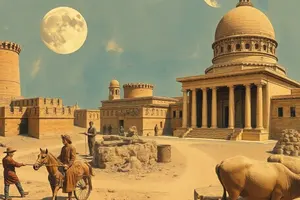Podcast
Questions and Answers
Which of the following best explains the relationship between archaeology and material culture?
Which of the following best explains the relationship between archaeology and material culture?
- Material culture encompasses only written records, while archaeology deals with physical sites.
- Archaeology and material culture are unrelated fields of study with different focuses.
- Material culture is the primary source of evidence that archaeologists use to study past human societies. (correct)
- Archaeology is a subfield of material culture, focusing specifically on prehistoric tools.
How does ethnoarchaeology contribute to the study of past societies?
How does ethnoarchaeology contribute to the study of past societies?
- By using modern-day societies to interpret ancient human behaviors and cultural practices. (correct)
- By focusing on the history of museums and the preservation of artifacts.
- By analyzing ancient DNA to determine genetic relationships between different cultures.
- By studying the impact of climate change on archaeological sites.
Which of the following theoretical approaches in archaeology emphasizes the importance of understanding cultural change through scientific analysis and quantitative data?
Which of the following theoretical approaches in archaeology emphasizes the importance of understanding cultural change through scientific analysis and quantitative data?
- Culture History
- Feminist Archaeology
- Processual Archaeology (correct)
- Post-Processual Archaeology
A newly discovered archaeological site contains a series of distinct layers of soil and sediment. Which principle would archaeologists primarily use to determine the relative ages of artifacts found in these layers?
A newly discovered archaeological site contains a series of distinct layers of soil and sediment. Which principle would archaeologists primarily use to determine the relative ages of artifacts found in these layers?
Which of the following survey methods is most likely to be employed to discover archaeological sites in heavily forested areas?
Which of the following survey methods is most likely to be employed to discover archaeological sites in heavily forested areas?
In archaeological excavation, what does 'context' refer to, and why is it important?
In archaeological excavation, what does 'context' refer to, and why is it important?
An archaeologist discovers a series of stone tools at a prehistoric site. What type of analysis would they most likely use to understand the tool's function, technology, and use?
An archaeologist discovers a series of stone tools at a prehistoric site. What type of analysis would they most likely use to understand the tool's function, technology, and use?
Which of the following theoretical approaches in archaeology is most concerned with issues of power, ideology, and the subjective nature of interpretation?
Which of the following theoretical approaches in archaeology is most concerned with issues of power, ideology, and the subjective nature of interpretation?
Which of the following processes would be considered a site formation process that could affect the preservation of an archaeological site?
Which of the following processes would be considered a site formation process that could affect the preservation of an archaeological site?
In the context of archaeological research, what distinguishes 'non-site archaeology' from traditional site-based studies?
In the context of archaeological research, what distinguishes 'non-site archaeology' from traditional site-based studies?
During an excavation, archaeologists carefully record the exact location of each artifact they find. Why is this level of precision so important?
During an excavation, archaeologists carefully record the exact location of each artifact they find. Why is this level of precision so important?
An archaeologist is working on a site and needs to determine the age of a piece of wood. Which dating method would be most appropriate?
An archaeologist is working on a site and needs to determine the age of a piece of wood. Which dating method would be most appropriate?
Which of the following best describes the ethical considerations archaeologists must address when excavating human remains?
Which of the following best describes the ethical considerations archaeologists must address when excavating human remains?
How has the use of Geographic Information Systems (GIS) impacted archaeological research?
How has the use of Geographic Information Systems (GIS) impacted archaeological research?
What role does Cultural Resource Management (CRM) play in contemporary archaeology?
What role does Cultural Resource Management (CRM) play in contemporary archaeology?
What is taphonomy, and why is it important in archaeology?
What is taphonomy, and why is it important in archaeology?
How do archaeologists typically distinguish between artifacts, ecofacts, and features?
How do archaeologists typically distinguish between artifacts, ecofacts, and features?
Why is public archaeology important, and what are its primary goals?
Why is public archaeology important, and what are its primary goals?
How does post-colonial archaeology differ from traditional archaeological approaches?
How does post-colonial archaeology differ from traditional archaeological approaches?
What is the purpose of a 'test excavation,' and when would archaeologists typically use this method?
What is the purpose of a 'test excavation,' and when would archaeologists typically use this method?
Flashcards
Archaeology
Archaeology
The study of human history and prehistory through the excavation of sites and the analysis of artifacts and other physical remains.
Material Culture
Material Culture
Physical objects created or modified by humans, including artifacts, tools, and structures.
Prehistory
Prehistory
The period of human history before the advent of writing.
Ethnoarchaeology
Ethnoarchaeology
Signup and view all the flashcards
Culture History
Culture History
Signup and view all the flashcards
Stratigraphy
Stratigraphy
Signup and view all the flashcards
Processual Archaeology
Processual Archaeology
Signup and view all the flashcards
Post-Processual Archaeology
Post-Processual Archaeology
Signup and view all the flashcards
Survey
Survey
Signup and view all the flashcards
Excavation
Excavation
Signup and view all the flashcards
Context
Context
Signup and view all the flashcards
Dating Techniques
Dating Techniques
Signup and view all the flashcards
Lithic Analysis
Lithic Analysis
Signup and view all the flashcards
Site Formation Processes
Site Formation Processes
Signup and view all the flashcards
Artifacts
Artifacts
Signup and view all the flashcards
Stratigraphy
Stratigraphy
Signup and view all the flashcards
Test Excavation
Test Excavation
Signup and view all the flashcards
Radiocarbon Dating
Radiocarbon Dating
Signup and view all the flashcards
Dendrochronology
Dendrochronology
Signup and view all the flashcards
Taphonomy
Taphonomy
Signup and view all the flashcards
Study Notes
- Archaeology studies human history and prehistory using material remains such as artifacts, structures, and environmental data.
- Material culture includes physical objects that humans create or modify, offering insights into past societies.
- Cultural anthropology studies human cultures and societies and complements archaeology.
- Prehistory is the period of human history before written records.
- Ethnoarchaeology uses modern societies to understand ancient human behaviors and cultural practices.
History of Archaeology
- Culture history documents and classifies the material culture from different time periods and regions.
- Stratigraphy studies layers of sediment or soil at a site to understand the chronological sequence of deposition.
- Processual archaeology uses scientific methods to understand cultural change and human behavior.
- Post-processual archaeology emphasizes subjective interpretation, human agency, symbolism, and the role of power in shaping archaeological narratives.
Methods of Archaeological Research
- Survey systematically searches a landscape for sites, using methods like pedestrian survey or remote sensing.
- Excavation digs and documents a site to uncover and recover material remains.
- Context encompasses the spatial and temporal relationships of artifacts and features and is crucial for understanding their meaning.
- Dating techniques like radiocarbon dating, dendrochronology, and stratigraphy determine the age of artifacts and sites.
- Lithic analysis studies stone tools to understand their function, technology, and use.
Archaeological Theory
- Culture history identifies and describes cultures through material remains.
- Processualism uses scientific analysis to understand the processes that drive cultural change and human behavior.
- Post-processualism critiques the scientific objectivity of processualism, emphasizing subjectivity, symbolism, and the role of power.
- Materialism suggests material culture can provide insights into social structure, economic systems, and cultural values.
Archaeological Sites and Surveys
- Site formation processes are natural and human processes affect the creation and preservation of sites.
- Survey methods identify and map sites, such as walking over a landscape, using aerial surveys, and remote sensing technologies.
- Non-site archaeology studies material that does not originate from a single site.
- Artifacts are objects made or modified by humans that provide clues about past cultures and technologies.
Excavation and Stratigraphy
- Stratigraphy states that layers of earth are deposited in a sequence, with the oldest layers at the bottom and the youngest on top.
- Excavation units are the specific areas of a site that archaeologists dig, often defined in a grid.
- Contextual analysis studies the spatial and temporal relationships between artifacts, features, and ecofacts to interpret their meaning.
- Test excavation are small, preliminary excavations to assess a site's potential significance.
Important Archaeological Methods and Techniques
- Survey systematically searches a landscape for archaeological sites, using methods like pedestrian survey or remote sensing.
- Excavation digs and documents a site to uncover and recover material remains.
- Grid systems, screening, mapping, and documentation tools and techniques are used in surveys and excavations
- Radiocarbon dating dates organic materials.
- Dendrochronology is tree-ring dating.
- Stratigraphy helps us understand the layering of soil and sediment over time
- Remote sensing uses ground-penetrating radar, LIDAR, and aerial surveys to discover and analyze sites.
Key Figures in Archaeology
- Lewis Binford is a key figure in processual archaeology.
- Ian Hodder is a key figure in post-processualism.
Theoretical Approaches
- Culture history focuses on identifying and describing cultures through their material remains.
- Processualism emphasizes the need for scientific analysis to understand cultural change
- Post-Processualism highlights subjectivity, symbolism, and the role of power in historical narratives.
- Post-colonial archaeology and feminist archaeology are newer theoretical approaches.
Site Formation and Taphonomy
- Weathering, erosion, looting, or farming can affect the preservation of sites.
- Taphonomy studies how organisms decay and fossilize, which is important for understanding how archaeological materials preserve over time.
Artifacts, Ecofacts, and Features
- Artifacts includes human-made objects (tools, pottery, etc.) that provide insight into culture
- Ecofacts are organic remains like animal bones and seeds that are not altered but are useful.
- Features non-portable archaeological evidence, such as hearths, walls, or storage pits.
Site Interpretation
- Archaeologists reconstruct past lifeways through material remains.
- Context is important in interpreting the meaning of artifacts and features within a site.
Ethics in Archaeology
- Ethical issues surround archaeology, including preservation of cultural heritage.
- It is important to focus on the handling of human remains, including repatriation of indigenous remains.
- Understanding the role of archaeologists in contemporary societies.
Recent Developments and Challenges in Archaeology
- Public archaeology involves local communities in archaeological projects, and the importance of engaging with the public.
- Cultural resource management involves archaeologists in the protection of cultural resources during development projects.
- Digital archaeology makes use of 3D modeling, GIS, and digital mapping in archaeological work.
Case Studies and Examples
- Pompeii and Stonehenge are major archaeological discoveries and examples for studies them.
- Excavation and remote sensing are methods used to study these sites.
Studying That Suits You
Use AI to generate personalized quizzes and flashcards to suit your learning preferences.




